| Author |
Message |
Chad Arnow
myArmoury Team


|
 Posted: Wed 14 Feb, 2007 12:02 pm Post subject: Wallace Collection ballock dagger Posted: Wed 14 Feb, 2007 12:02 pm Post subject: Wallace Collection ballock dagger |
 |
|
I've always liked the Wallace Collection ballock dagger set. I'm actually thinking about having a set made that would be somewhat loosely based on it.
Here's my question: Is this dagger (or ballock daggers of its era c. 1450) more of a civilian weapon than a military one? The blade is over 10 inches long, which might be long for a civilian weapon. Looking at effigies and brasses, rondel daggers seem to be pretty popular for military folks. It's actually not easy to find ballock daggers represented after say 1425 or so.

ChadA
http://chadarnow.com/
|
|
    |
 |
|
Justin King
Industry Professional
|
 Posted: Thu 15 Feb, 2007 7:00 pm Post subject: Posted: Thu 15 Feb, 2007 7:00 pm Post subject: |
 |
|
|
Likely to depend on region as well as time period. "Arms & Armor of the Medieval Knight " shows a Flemish or German ballock dagger c 1550 with a scabbard, by-knife and pricker. Some dudgeon daggers bear a strong resemblance to ballocks and the dirk is widely considered to be a later variant, both of these were also popular in regions where German blades were in high demand in later periods, so it may be that it was popular longer in northern Europe. Rondels seem to me to be much more represented on effigies though, from what I have seen (which is limited).
|
|
  |
 |
Chad Arnow
myArmoury Team


|
 Posted: Thu 15 Feb, 2007 7:19 pm Post subject: Posted: Thu 15 Feb, 2007 7:19 pm Post subject: |
 |
|
| Justin King wrote: | | Likely to depend on region as well as time period. "Arms & Armor of the Medieval Knight " shows a Flemish or German ballock dagger c 1550 with a scabbard, by-knife and pricker. |
The ballock dagger in the Edge/Paddock book is the dagger from the Wallace Collection I'm asking about. Edge/Paddock dates it ~1550. The James Mann catalogue of the Wallace Collection puts it at ~1450. The Guy Laking Wallace catalogues call it ~1520. Logan Thompson's Daggers and Bayonets dates it to ~1450 as well.
I wonder what the most recent dating trend is for that dagger set. I'm looking for something circa ~1450.

ChadA
http://chadarnow.com/
|
|
    |
 |
Richard Fay

|
 Posted: Fri 16 Feb, 2007 1:19 pm Post subject: Posted: Fri 16 Feb, 2007 1:19 pm Post subject: |
 |
|
Hello all!
| Chad Arnow wrote: |
Here's my question: Is this dagger (or ballock daggers of its era c. 1450) more of a civilian weapon than a military one? The blade is over 10 inches long, which might be long for a civilian weapon. Looking at effigies and brasses, rondel daggers seem to be pretty popular for military folks. It's actually not easy to find ballock daggers represented after say 1425 or so. |
Hey Chad! 
While the rondel dagger, or a variant of it with a "scent stopper" pommel, seems more common on the English brasses of the fifteenth century, the ballock dagger does occasionally show up in fifteenth century art. It seems to have remained a popular choice of dagger in Germany especially, at least according to those ballock daggers shown in art.
In Arms and Armour of the Medieval Knight by David Edge and John Miles Paddock, in the chapter about the fifteenth century, there is a painting of Saint George by Roger van der Weyden, Flemish, circa 1432. If you look closely, the dagger attached to the faulds at the saint's hips appears to be a rather small ballock dagger. It has a discoid pommel with the grip tapering down to what may be two bulbous quillons. It's hard to see, because the bulbous quillons are coloured just like the rivets in the lames of the fauld, but a careful inspection of the painting shows that they are at a different angle than the rivets. I would think that the dagger could be interpreted as a ballock dagger.
There are a few other possible depictions of ballock daggers worn by armoured warriors in German art of the fifteenth century. These seem to show that it remained popular from the early fifteenth century and through at least the second quarter of the fifteenth century.
One ballock dagger appears on the effigy of Ludwig of Hutten, died 1414. It appears in a drawing in J. H. Hefner-Alteneck's Medieval Arms and Armor: A Pictorial Archive. This is not mid-fifteenth, it's early-fifteenth, but it shows a ballock dagger still being caried by an armoured warrior in the fifteenth century.
Another occurs on the tomb effigy of Kunz Haberkorn, died 1421 (see photos below). The dagger is damaged on the effigy, but it appears to have bulbous quillons like a typical ballock dagger. It is more clearly of a ballock-dagger shape in the drawing of the effigy in Hefner-Alteneck's archive. I have no reason to doubt Hefner-Alteneck's interpretation of the remnants of the dagger as looking like a ballock dagger. Look at the close-up image I posted. See where the arrow points; there are two distinct "bulbs (the top one is more distinct than the bottom).
Yet another possible ballock dagger appears on a German sculpture of an armoured warrior from circa 1435. In Vesey Norman's Arms and Armor, the sculpture is described as the tomb of Duke Ludwig of Bayern-Ingolstadt by Hans Multsher. It looks to me as if the quillons of the dagger are a bit "bulbous"; look at the line between the upper quillon and the grip. This suggests that ballock daggers were still in use by armoured warriors in Germany until at least the second quarter of the fifteenth century.
Finally, there is another Flemish example. This one is from an altar panel painted by Jan van Eyck, dated to circa 1430. One of the fully armoured warriors (the one in the foreground) wears a distinctive ballock dagger at his hip. Since this figure is in similar armour, and from a similar period and place as the painting of Saint George by Roger van der Weyden, it lends support to my interpretation of Saint George's dagger as a ballock dagger. This painting appears in Paul Martin's Arms and Armor from the 19th to the 17th Century.
There are also some surviving ballock daggers that certain sources date to the mid-fifteenth century. There is an interesting plate showing ballock daggers in Medieval Costume, Armor & Weapons by Eduard Wagner, zoroslava Drobna, and Jan Durdik. Below, I've posted the section of the plate showing ballock daggers. Number (1) is a 14th century Danish dagger from Zeitschrift fur historische Waffenkunde, 1929/1931, p. 269, pl. 2. Number (2) is a 14th century Bohemian dagger in the Prague Municipal Museum. Number (3) is a dagger dating from between 1430-50. Number (4) is a dagger dating from 1400-20. Number (5) is an English dagger from 1450-60. And number (6) is another English dagger, this time from 1440-50 (numbers 3-6 are all from European Armour III).
I know the period art isn't as late as 1450, but I hope this information was helpful just the same.
Stay safe!
 Attachment: 54.8 KB Attachment: 54.8 KB
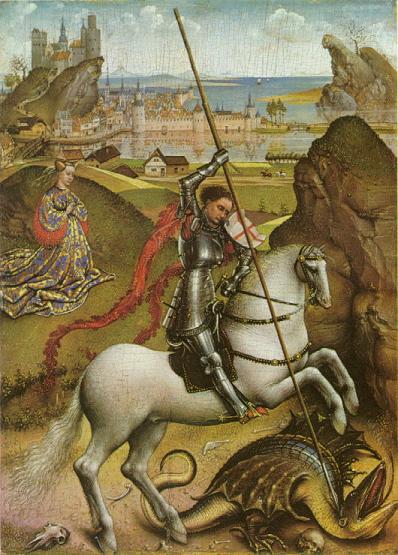
St. George by Roger van der Weyden, circa 1432.
 Attachment: 22.91 KB Attachment: 22.91 KB
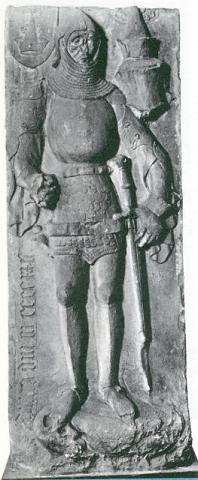
Effigy of Kunz Haberkorn, died 1421.
 Attachment: 18.22 KB Attachment: 18.22 KB
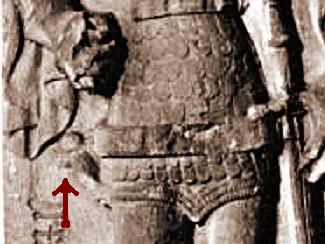
Close-up of Haberkorn's dagger. Note the round "bulbs" for a quillon.
 Attachment: 53.53 KB Attachment: 53.53 KB
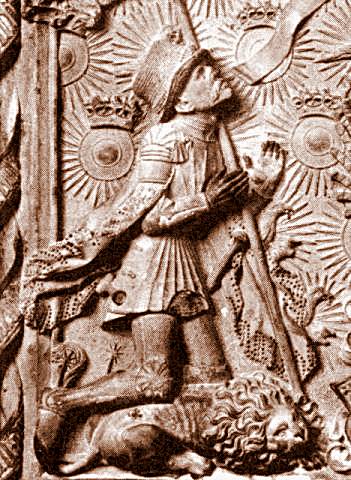
German sculpture, circa 1435. Note the possible ballock dagger.
 Attachment: 70.09 KB Attachment: 70.09 KB
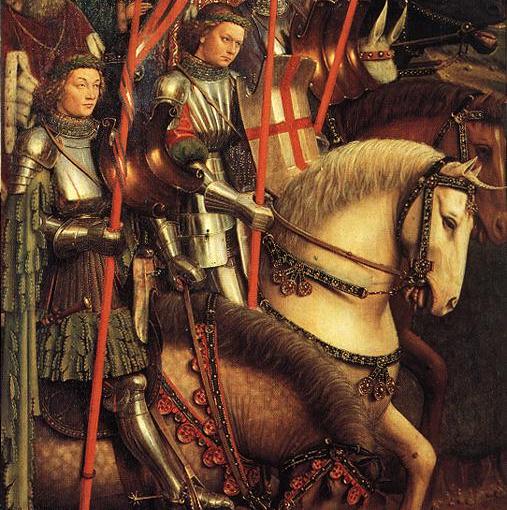
Detail of altar panel depicting the Knights of Christ in full armour, Jan van Eyck, 1430-40
 Attachment: 34.48 KB Attachment: 34.48 KB
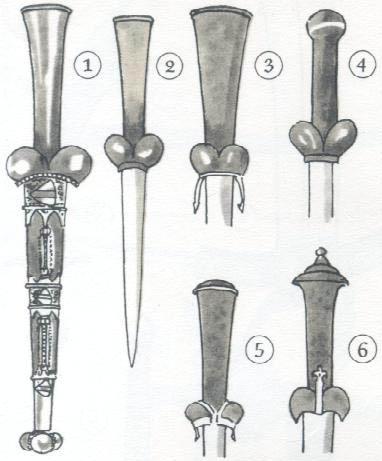
Ballock Dagers from Plate 11, Part V of Wagner, et al.
"I'm going to do what the warriors of old did! I'm going to recite poetry!"
Prince Andrew of Armar
|
|
 |
 |
Merv Cannon

|
 Posted: Sat 17 Feb, 2007 6:02 am Post subject: Scale Skirt ? Posted: Sat 17 Feb, 2007 6:02 am Post subject: Scale Skirt ? |
 |
|
Ref new post
Merv ....... KOLR
http://www.lionrampant.com.au/
"Then let slip the dogs of war ! "......Woof !
Last edited by Merv Cannon on Sat 17 Feb, 2007 2:59 pm; edited 1 time in total
|
|
   |
 |
Chad Arnow
myArmoury Team


|
 Posted: Sat 17 Feb, 2007 7:08 am Post subject: Re: Scale Skirt ? Posted: Sat 17 Feb, 2007 7:08 am Post subject: Re: Scale Skirt ? |
 |
|
| Merv Cannon wrote: | Hi Richard...Sorry, Chad if this is off the subject ( but, I hope not off-Topic) .....but......is that some sort of scale skirt that Haberkorn is wearing below his Gambeson ? Sort of looks that way to me....if so, I dont remember seeing one before.
Cheers |
It is off-topic for this thread. I don't want to see the discussion go down this route, as I really want more info on this dagger. If you want to discuss it further, please make a new thread. Thanks! 

ChadA
http://chadarnow.com/
|
|
    |
 |
Chad Arnow
myArmoury Team


|
 Posted: Sat 17 Feb, 2007 7:12 am Post subject: Posted: Sat 17 Feb, 2007 7:12 am Post subject: |
 |
|
Richard,
Thanks for the information. I'd already looked through the Hefner-Alteneck book and some others. I was really looking for info more closely related to circa 1450.
Does anyone have any thoughts on the date of the Wallace set? Various publications date it anywhere between 1450 and 1550.

ChadA
http://chadarnow.com/
|
|
    |
 |
|
Jonathan Hopkins
|
 Posted: Sat 17 Feb, 2007 1:04 pm Post subject: Posted: Sat 17 Feb, 2007 1:04 pm Post subject: |
 |
|
Disclaimer: Medieval and Renaissance weapons are not an area in which I have tremendous knowledge...
...but I do have some Peter Finer catalogs and have found a very similar ballock dagger that is dated to c.1470 (Peter Finer IN ARMIS ARS MMI, item 9). The date is based on the hilt form:
A Fine and Rare French or English Ballock Dagger, the silver mounts bearing shields engraved with the arms of Grandison, circa 1470
This dagger can be dated to the seconf half of the 15th century on the basis of the shape of the guard mount, formed of curious indented terminals which are probably intended to represent dragons' heads. Fully representational dragons' heads folded close down the blade appear on th ewell-known Burgundian dagger made for Johann Amerbach-Ortenberg, now in the Historisches Museum, Basel. It has been dated to the late 15th century.
The distinctive grip with large lobes and tapering profile is a feature that appears on a number of daggers which can be dated to the late 15th century. These include examples from the Laking, Keasby, and Wallace collections.
Overall length: 17 3/4"
Blade length: 12 3/8"
Please see attachment for photos.
Jonathan
 Attachment: 72.74 KB Attachment: 72.74 KB
[ Download ]
|
|
  |
 |
Richard Fay

|
 Posted: Sat 17 Feb, 2007 2:08 pm Post subject: Posted: Sat 17 Feb, 2007 2:08 pm Post subject: |
 |
|
| Chad Arnow wrote: | Richard,
Thanks for the information. I'd already looked through the Hefner-Alteneck book and some others. I was really looking for info more closely related to circa 1450.
Does anyone have any thoughts on the date of the Wallace set? Various publications date it anywhere between 1450 and 1550. |
Hey Chad! 
The last bit of what I posted, from the Wagner et al. book, had at least a couple ballock daggers dated to the mid fifteenth century. However, I couldn't find any images that showed a ballock dagger worn by an armoured warrior dating after about 1435. I would say ballock daggers were definitely in use through the fifteenth century, but possibly in a civilian context more than a military one.
By the way, one of the "English daggers" in the Wagner et al. work may be the Wallace dagger. They got their information from European Armour III (Laking, I believe). I'll look around more and see what I can find.
(I figured I would post what I found for ballock daggers in the fifteenth century, even though they don't seem to date as late as 1450.)
Stay safe!
"I'm going to do what the warriors of old did! I'm going to recite poetry!"
Prince Andrew of Armar
|
|
 |
 |
Richard Fay

|
 Posted: Sat 17 Feb, 2007 3:03 pm Post subject: Posted: Sat 17 Feb, 2007 3:03 pm Post subject: |
 |
|
Hello all!
Hey Chad! 
I found a couple similar ballock daggers dated to the late fifteenth or early sixteenth century. Both are in Claude Blair's European & American Arms. And, both have similar down-drooping metal quillons under the "bulbs" of the wooden grip.
One Is a German ballock-knife (Blair calls them ballock-knives) of the late fifteenth century. It is, or was, in the Metropolitan Museum of Art, number 26.145.17. It's 390 mm long (about 15.35 inches). It has a larger flat, discoid pommel (Blair calls it a washer), with a greater flare toward the quillons than the Wallace collection ballock dagger, but it does have similarly-shaped down-turned metal quillons.
The other is an actual knife set, with a ballock dagger and accessories, of Johann Amerbach-Ortenburg (1430-1513). It's a Burgundian example of the late fifteenth century. The grip is of agate, of a more explicit shape (if you know what I mean) than the Wallace collection dagger. It has mounts of silver-gilt, of a similar shape to the Wallace collection dagger, but of a more decorated nature. It is, or was, in the Historisches Museum, Basel (Number 1882. 109).
Since both the daggers mentioned above have some features in common with the Wallace Collection dagger, one even being a dagger set with accessories, I think you could date the Wallace Collection dagger to the mid-late fifteenth century. It may be a possibility, anyway.
In case this is helpful at all, I'll include the general information Claude Blair penned about ballock daggers in the same work:
| Claude Blair wrote: |
Ballock-knife. A dagger or knife, normally worn by civilians, with a guard formed by two rounded lobes, often made in one with the wooden grip and reinforced on top with a shaped metal washer. This form - which was christened a kidney-dagger by prudish nineteenth-century antiquaries - first appeared in c. 1300 and was widely used, especially in Flanders, England and Scotland, until the early seventeenth century. The hilt was often made of dudgeon (box root) whence, in the sixteenth and seventeenth centuries, the whole dagger seems sometimes to have been called a dudgeon-dagger. It was probably, though not certainly, the predecessor of the Scottish dirk. |
This isn't anywhere as specific as the daggers in Blair's work, but there are also a couple of ballock daggers in Sword and Hilt Weapons, in the chapter "The Renaissance Spirit" by Donald J. LaRocca, that are dated to the fifteenth century. One is roughly similar to the Wallace Collection dagger, with the small, down-drooping metallic quillons, but in excavated condition. The other is a bit different, with very small, triple "bulbs" of the hilt, and a triple-edged blade.
In a plate of drawings of daggers in The Complete Encyclopedia of Arms & Weapons, edited by Claude Blair and Leonid Tarassuk, there is a ballock dagger of the same general for as the Wallace Collection dagger (it may even be that particular one) that is dated to the second half of the fifteenth century. The caption doesn't list any more details, but the drawing is very similar to the Wallace Collection dagger. That may have been the inspiration for the illustration.
I think it may be possible that the Wallace Collection ballock dagger dates to the second half of the fifteenth century. Blair seemed to believe daggers of a similar form dated to that time period.
I hope this helped!
Stay safe!
"I'm going to do what the warriors of old did! I'm going to recite poetry!"
Prince Andrew of Armar
|
|
 |
 |
|
Jonathan Hopkins
|
 Posted: Sat 17 Feb, 2007 5:09 pm Post subject: Posted: Sat 17 Feb, 2007 5:09 pm Post subject: |
 |
|
Richard,
I have found the opposite to be true regarding 16th century ballock daggers--that's almost all I could find in my books. As far as art, here is an image of Saint Eustace by Durer from 1503, and he has what appears to be a nice ballock dagger hanging at his right hip:
 Attachment: 31.34 KB Attachment: 31.34 KB
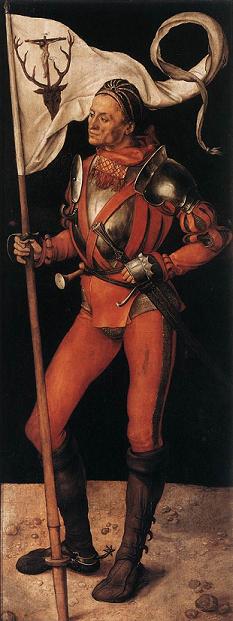
|
|
  |
 |
Richard Fay

|
 Posted: Sat 17 Feb, 2007 5:34 pm Post subject: Posted: Sat 17 Feb, 2007 5:34 pm Post subject: |
 |
|
| Jonathan Hopkins wrote: | Richard,
I have found the opposite to be true regarding 16th century ballock daggers--that's almost all I could find in my books. As far as art, here is an image of Saint Eustace by Durer from 1503, and he has what appears to be a nice ballock dagger hanging at his right hip: |
Hi Jonathan! 
I actually find far more ballock daggers depicted on armoured warriors of the fourteenth century. They seem to have been somewhat replaced in a military context in the fifteenth century by the rondel dagger. The Durer painting does suggest that they could be used by armoured warriors in the early sixteenth as well.
I know I looked at that image a day or two ago on one web site or another (I think it was the Web Gallery of Art). How did I miss that the saint wears a ballock dagger? 
Stay safe!
"I'm going to do what the warriors of old did! I'm going to recite poetry!"
Prince Andrew of Armar
|
|
 |
 |
Chad Arnow
myArmoury Team


|
|
    |
 |
Nathan Robinson
myArmoury Admin


|
 Posted: Thu 22 Mar, 2007 11:25 am Post subject: Posted: Thu 22 Mar, 2007 11:25 am Post subject: |
 |
|
To me, "battlefield weapon" would indicate a primary weapon rather than any backup weapons or tools that may also have been carried onto the battlefield. Many ballock daggers of all sizes and with various degrees of ornamentation would find themselves on the battlefield but one might not be wrong in avoiding calling them "battlefield weapons". One instead might look at the function of a dagger in general, and a ballock dagger more specifically, and recognize the roles such things had. I don't, personally, see any form of ballock dagger as being accuracy called a battlefield weapons. The term attempts to be a very specific definition, but still manages to leave out a lot of info.
.:. Visit my Collection Gallery :: View my Reading List :: View my Wish List :: See Pages I Like :: Find me on Facebook .:.
|
|
    |
 |
Chad Arnow
myArmoury Team


|
 Posted: Thu 22 Mar, 2007 4:03 pm Post subject: Posted: Thu 22 Mar, 2007 4:03 pm Post subject: |
 |
|
| Nathan Robinson wrote: | | To me, "battlefield weapon" would indicate a primary weapon rather than any backup weapons or tools that may also have been carried onto the battlefield. Many ballock daggers of all sizes and with various degrees of ornamentation would find themselves on the battlefield but one might not be wrong in avoiding calling them "battlefield weapons". One instead might look at the function of a dagger in general, and a ballock dagger more specifically, and recognize the roles such things had. I don't, personally, see any form of ballock dagger as being accuracy called a battlefield weapons. The term attempts to be a very specific definition, but still manages to leave out a lot of info. |
Let me see if I can clarify my thoughts.  Is this dagger's form (hilt and/or blade) well-suited enough to be a solid backup weapon on the battlefield for a fairly well-to-do gentleman? Or would it most likely be replaced on the battlefield by something better suited to a combat role? If the latter, why is it not suitable? Is this dagger's form (hilt and/or blade) well-suited enough to be a solid backup weapon on the battlefield for a fairly well-to-do gentleman? Or would it most likely be replaced on the battlefield by something better suited to a combat role? If the latter, why is it not suitable?

ChadA
http://chadarnow.com/
Last edited by Chad Arnow on Fri 23 Mar, 2007 6:22 am; edited 1 time in total
|
|
    |
 |
Jean Thibodeau

|
 Posted: Thu 22 Mar, 2007 9:35 pm Post subject: Posted: Thu 22 Mar, 2007 9:35 pm Post subject: |
 |
|
Chad;
Avoiding getting stuck on definition of words i.e. " battlefield weapons " I would think that if a blade type that would seem like a good backup weapon for armoured combat is used with a ballock styled hilt, I tend to think there would be no distinction as far as practical use is concerned.
If a rondel was only worn with armour and rarely worn with civilian clothes there might be a cultural / legalistic prohibition to wear one " in everyday carry ". The ballock seems to have been very O.K. for civilian wear but might also have been used in war ? Not, sure if these distinctions actually were true or just a modern interpretation. ( Assuming that this interpretation is actually more than in just my mind based on the fact that we are asking the question ??? )
Oh, and I see many blades that would work as a rondel blade also being used in ballock daggers.
Also, some ballock single edge blades that look more general purpose knives that could be pressed into service as weapons or used to attack a roast chicken. 
You can easily give up your freedom. You have to fight hard to get it back!
|
|
  |
 |
|
Manouchehr M.
|
|
   |
 |
Jean Thibodeau

|
 Posted: Thu 22 Mar, 2007 11:00 pm Post subject: Posted: Thu 22 Mar, 2007 11:00 pm Post subject: |
 |
|
| Manouchehr M. wrote: | Gentlemen,
Is it correct to say that rondel daggers were used only on battlefields? Or were they also used as civilian daggers?
Kind regards
Manouchehr |
I honestly don't know ? I too am wondering about this ?
From a purely functional point of view and for general purpose use the ballock might be easier to use as a tool while the rondel type handle may make the grip hard to use except as a stabbing weapon hammer grip or ice pic grip.
If forbidden for civilian carry this might vary regionally ( local ordinances ? ) and/or by period ?
There might be exceptions to prohibitions for nobles or military on active duty ?
You can easily give up your freedom. You have to fight hard to get it back!
|
|
  |
 |
Andreas Auer

|
 Posted: Fri 23 Mar, 2007 3:00 am Post subject: Posted: Fri 23 Mar, 2007 3:00 am Post subject: |
 |
|
Hi Folks !
this is my second entry in this forum, and i just wanted to say thanks for your interesting replys...
i live in Innsbruck austria, and we have a rich culture in Late medieval warfare...(Maximilian I). i investigated all "roundel daggers" in my area. in german they are called "Scheibendolch" or diskdagger...and everyone have a pure thrustigblade to penetrate platearmour. and every bollockdagger i saw have one or twosided cuttingblades not very effective on thrusting on the battlefield at this times (ca.1450 to 1490). so my thoughts on this are bullockdaggers were a kind of everyday allpurpose tool or knive (sure could be used to defend or attack) and a scheibendolch was a pure battlefield weapon...
so these are my observations, what do you think?
Andreas Auer
Innsbruck
Tirol
|
|
   |
 |
|
Jeff Ross
Location: Apex, NC Joined: 30 Jul 2004
Posts: 33
|
 Posted: Fri 23 Mar, 2007 4:29 am Post subject: Posted: Fri 23 Mar, 2007 4:29 am Post subject: |
 |
|
I find it interesting that Talhoffer shows ballock daggers in his 1443 dagger section, but in the 1459 dagger version shows rondel daggers in use. These are both unarmored single combat, same author, 15 years difference in time. Perhaps this reflects a change in local popularity between the styles in the mid 15th century? Does not seem to be a battlefield vs civilian difference in context though.
Jeff Ross
 Attachment: 54.74 KB Attachment: 54.74 KB

Talhoffer 1443
 Attachment: 29.32 KB Attachment: 29.32 KB
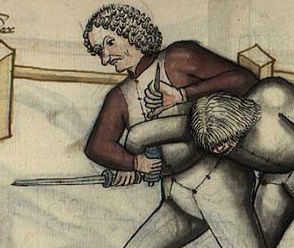
Talhoffer 1459
|
|
  |
 |
|
|
You cannot post new topics in this forum
You cannot reply to topics in this forum
You cannot edit your posts in this forum
You cannot delete your posts in this forum
You cannot vote in polls in this forum
You cannot attach files in this forum
You can download files in this forum
|
All contents © Copyright 2003-2025 myArmoury.com — All rights reserved
Discussion forums powered by phpBB © The phpBB Group
Switch to the Basic Low-bandwidth Version of the forum
|

